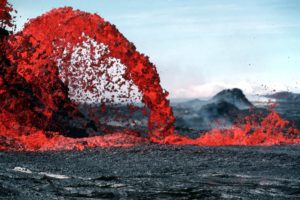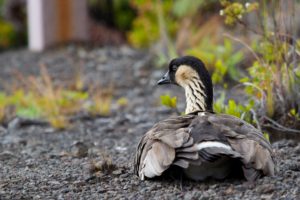On August 1, 1916, President Woodrow Wilson signed the bill establishing Hawaii National Park as the nation’s 13th national park. The original park included three volcanoes—Kilauea and Mauna Loa on the island of Hawaii and Haleakala on the island of Maui. In 1961, the areas on the two different islands were separated into two parks—Hawaii Volcanoes National Park on Hawaii and Haleakala National Park on Maui.
The park’s features first came to the nation’s attention in the early 1840s, when the U.S. Exploring Expedition landed there as part of a surveying voyage through the South Pacific. Their report stimulated the beginnings of tourism visits. Mark Twain experienced Kilauea in 1866, declaring, “Here was room for the imagination to work.” Although the park was established in 1916, little was done at first to make it accessible or to protect it. As one congressman quipped, “It should not cost anything to run a volcano.” Since that time, of course, Hawaii and its parks have become major tourist attractions. In 2016, nearly 2 million visitors enjoyed Hawaii Volcanoes National Park, making it the 14th most visited national park in the country.
The volcanoes of Hawaii are extraordinary for several reasons. First, they are the most active volcanoes in the world, offering a continuous look at the geological forces that created our landscapes. Second, they are the most gentle volcanoes, spewing lava and ash at a low rate that allows visitors to get close to these processes without endangering their lives (although great caution should be used and all rules and signs should be followed—these volcanoes are dangerous). The viewing opportunity is spectacular and unique in the world. The recent eruption of Kilauea is a contemporary example of both of these characteristics.

Third, and most important for ecological reasons, the Hawaiian Islands are the most distant set of islands from a mainland anywhere in the world. Consequently, the islands have developed a unique biota over 70 million years. And because the volcanic activity is constantly adding new land and covering over existing lands with new rock surface, the entire area remains in the earliest successional stages, demonstrating nature’s ability to colonize the rawest of the earth’s environment. Furthermore, Mauna Loa, as the world’s largest volcano, rises to more than 13,000 feet in elevation. Adding the depth to the bottom of the crater (and additional 18,000 feet) makes this the highest mountain in the world from base to summit—higher by far than Mt. Everest.
The Hawaiian Islands contain 54 federally protected endangered and threatened species. Among those is the Nene Goose, the state bird of Hawaii and a relative of the common Canada Goose. But almost everything about the Nene Goose, from reproductive habits to habitat use and distribution, is so different from the Canada Goose that the Nene is critically endangered. So is the Mauna Loa silversword, a plant that grows on the rocky slopes of the volcano and reproduces just once after decades of growth. Subject to grazing by feral pigs, the Mauna Loa silversword was at one time down to a few individual plants. Intense protection inside the park is now bringing the plant back.

Mauna Loa is also remarkable as a site for atmospheric research. High on the mountain is the federal government’s Mauna Loa Observatory, famous for its continuous monitoring of carbon dioxide levels in the air, a series going back to the 1950s. It is a perfect site for this work. Sitting high on the slopes of the volcano, it lies above the inversion layer that can dramatically change surface conditions daily. Because there is little or no vegetation growing there, the measurements are also unaffected by effects of plant metabolism, either removing or emitting chemicals into the air. And because it is so far from the mainland, few local pollution sources impact its measurements.
References:
Earth System Research Laboratory. About Mauna Loa Observatory. U.S. Department of Commerce, National Oceanic & Atmospheric Administration. Available at: https://www.esrl.noaa.gov/gmd/obop/mlo/aboutus/aboutus.html. Accessed August 1, 2017.
Hamilton, Dwight. History of Hawai’i Volcanoes National Park. National Park Service, Hawai’i Volcanoes National Park. Available at: https://www.nps.gov/havo/learn/kidsyouth/park-history.htm. Accessed August 1, 2017.
HawaiiHistory.org. Hawai’i National Park established. Available at: http://www.hawaiihistory.org/index.cfm?fuseaction=ig.page&pageid=321. Accessed August 1, 2017.
National Park Service. On the Brink of Extinction: Paradise in Peril. Hawai’i Volcanoes National Park. Available at: https://www.nps.gov/havo/learn/nature/onthebrink.htm. Accessed August 1, 2017.
National Park Service. Lieutenant Charles Wilkes. Hawai’i Volcanoes National Park. Available at: https://www.nps.gov/havo/learn/historyculture/lieutenant-charles-wilkes.htm. Accessed August 1, 2017.
